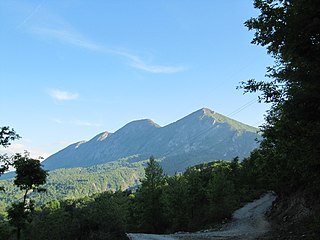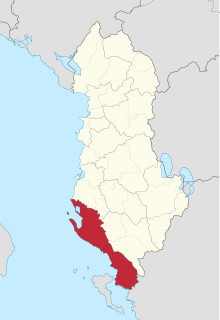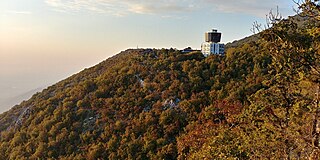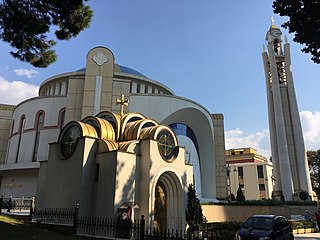
Tirana is the capital and largest city of Albania. It is located in the centre of the country, enclosed by mountains and hills with Dajti rising to the east and a slight valley to the northwest overlooking the Adriatic Sea in the distance. Due to its location at the Plain of Tirana and the close proximity to the Mediterranean Sea, the city is particularly influenced by a Mediterranean seasonal climate. It is among the wettest and sunniest cities in Europe, with 2,544 hours of sun per year.

Tourism in Albania has been a key element to the country's economic activity and is constantly developing. It is characterized by its rich archaeological and cultural heritage dating back to the classical period when Illyrians and Ancient Greeks inhabited the region. Over the course of history, the territory of Albania was occupied and populated by Romans, Byzantines, Venetians and Ottomans. Notably the country features unspoiled beaches, mountainous landscapes, traditional cuisine, archaeological artifacts, unique traditions, low prices and the wild atmosphere of the countryside.

Dajti standing at 1,613 m (5,292 ft) above sea level, is a mountain and national park on the edge of Tirana, Albania. The Dajti belongs to the Skanderbeg range. In winter, the mountain is often covered with snow, and it is a popular retreat to the local population of Tirana that rarely sees snow falls. Its slopes have forests of pines, oak and beech, while its interior contains canyons, waterfalls, caves, a lake, and an ancient castle.

Pogradec is the eleventh most populous city of the Republic of Albania and the capital of the eponymous municipality. It is located on a narrow plain between two mountain chains along the southwestern banks of the Lake of Ohrid. Its climate is profoundly influenced by a seasonal Mediterranean and Continental climate.

Dibër County is one of the 12 counties of the Republic of Albania, spanning a surface area of 2,586 square kilometres (998 sq mi) with the capital in Peshkopi. The county borders on the counties of Durrës, Elbasan, Kukës, Lezhë, Tirana and the country of North Macedonia. It is divided into the four municipalities of Bulqizë, Dibër, Klos and Mat. The municipalities are further subdivided into 290 towns and villages in total.

Durrës County, officially the County of Durrës, is a county in the Northern Region of the Republic of Albania. It is the smallest by area and the second most populous of the twelve counties, with 292,029 people within an area of 766 km2 (296 sq mi). The county borders on the Adriatic Sea to the west, the counties of Lezhë to the north, Dibër to the east and Tirana to the south. It is divided into three municipalities, Durrës, Krujë and Shijak, with all of whom incorporate sixteen administrative units.

Tirana County, officially the County of Tirana, is a county in the Central Region of the Republic of Albania. It is the tenth largest by area and the most populous of the twelve counties, with more than 895,000 people within an area of 1,652 km2 (638 sq mi). The county borders on the Adriatic Sea to the west, the counties of Durrës to the northwest, Dibër to the northeast, Elbasan to the east and Fier to the southwest. It is divided into five municipalities, Tirana, Kamëz, Kavajë, Rrogozhinë and Vorë, with all of whom incorporate twenty-nine administrative units.

Vlorë County is one of the 12 counties of the Republic of Albania with the capital in Vlorë. The county spans 2,706 square kilometres (1,045 sq mi) and has a total population of 188,922 people as of 2020. It borders the counties of Fier and Gjirokastër, as well as the Adriatic and Ionian Sea.

Petrelë is a village and a former municipality 15 km south of Tirana, in central Albania. It is part of Tirana County. At the 2015 local government reform it became a subdivision of the municipality Tirana. The population at the 2011 census was 5,542. It is known for its castle and history.

Petrelë Castle is a castle in Petrelë, central Albania. Its history dates back to Justinian I. Petrelë Castle is 329 metres (1,079 ft) above sea level.

The Skanderbeg Square is the main plaza in the centre of Tirana, Albania. The square is named after the Albanian national hero Gjergj Kastrioti Skënderbeu. The total area is about 40,000 square metres. The Skanderbeg Monument dominates the square.

The National History Museum is a historical museum in Tirana, Albania. It was opened on 28 October 1981 and is 27,000 square metres in size, while 18,000 square metres are available for expositions.

Dajti National Park is a national park established in 1966 in central Albania, spanning an area of 293.84 km2 (113.45 sq mi) since 2006. The park is 40 km (25 mi) east of the Adriatic Sea and 26 km (16 mi) east of Tirana. The area is under shared jurisdiction between Albanian Agency of Protected Areas (AKZM) and Tirana Municipality Parks and Recreation Agency (APR). It is adjacent to Shtamë Pass National Park to the northwest, Kraste-Verjon Protected Landscape to the west, and Mali me Gropa-Bizë-Martanesh Protected Landscape to the east. The park is marked by an extremely fragmented, rugged topography which creates favourable conditions for a great diversity of ecosystems and biodiversity.

Dajti Castle is a 1.12 hectares archaeological site in Albania, comprising the ruins of a Roman fortification and several dwellings. It belongs to late antiquity, probably having been built over Illyrian foundations. It lies at 1,200 metres (3,900 ft) altitude on top of a hill, west-side of Mount Dajti, close to Tirana. It was discovered in 1963 and eventually was inscribed in the list of the Cultural Monuments of Albania. In 2008 a three-year restoration project began, aiming to conduct further archaeological searching and surveys and to improve the nearby infrastructure for visitors and tourists.

The Central Mountain Range is a physiogeographical region encompassing the central and eastern edge of Albania. It comprises the mountainous inland extending all the way from the valley of Drin and the mountains of Sharr, Skanderbeg, Korab, and Shebenik-Jabllanicë, through the lakes of Ohrid and Prespa, until it reaches the village of Ersekë and the mountains of Pindus close to the border between the country and Greece.

Hotel Dajti was a hotel near Rinia Park on Dëshmorët e Kombit Boulevard in central Tirana, Albania. Carrying the name of nearby Dajti Mountain, it was the primary center for international visitors and diplomats during Albania's socialist period; the guest rooms were bugged with microphones, and there was a sub-basement floor for listening staff.

Skanderbeg Square is a square in Skopje, North Macedonia.

The architecture of Albania is a reflection of Albania's historical and cultural heritage. The country's architecture was influenced by its location within the Mediterranean Basin and progressed over the course of history as it was once inhabited by numerous civilisations including the Illyrians, Ancient Greeks, Romans, Byzantines, Venetians, Ottomans as well as modern Austro-Hungarians and Italians. In addition, missionaries, invaders, colonisers and traders brought cultural changes that had a large profound effect on building styles as well as techniques.

There are many landmarks in Tirana, Albania some of which are of considerable historical or artistic interest. Many monuments and landmarks situated in Tirana, date back to the Illyrian, Roman, Greek and Ottoman periods.

The Cave of Pëllumbas is a karst cave in central Albania, located in the Skorana Gorge close to the village of Pëllumbas in Tirana County. It lies about 500 m (1,600 ft) above the Adriatic, on the slopes of Dajti, a mountain chain that rises to an elevation of 1,613 m (5,292 ft). The cave is one of among six karstic caves that exist in Europe.


















